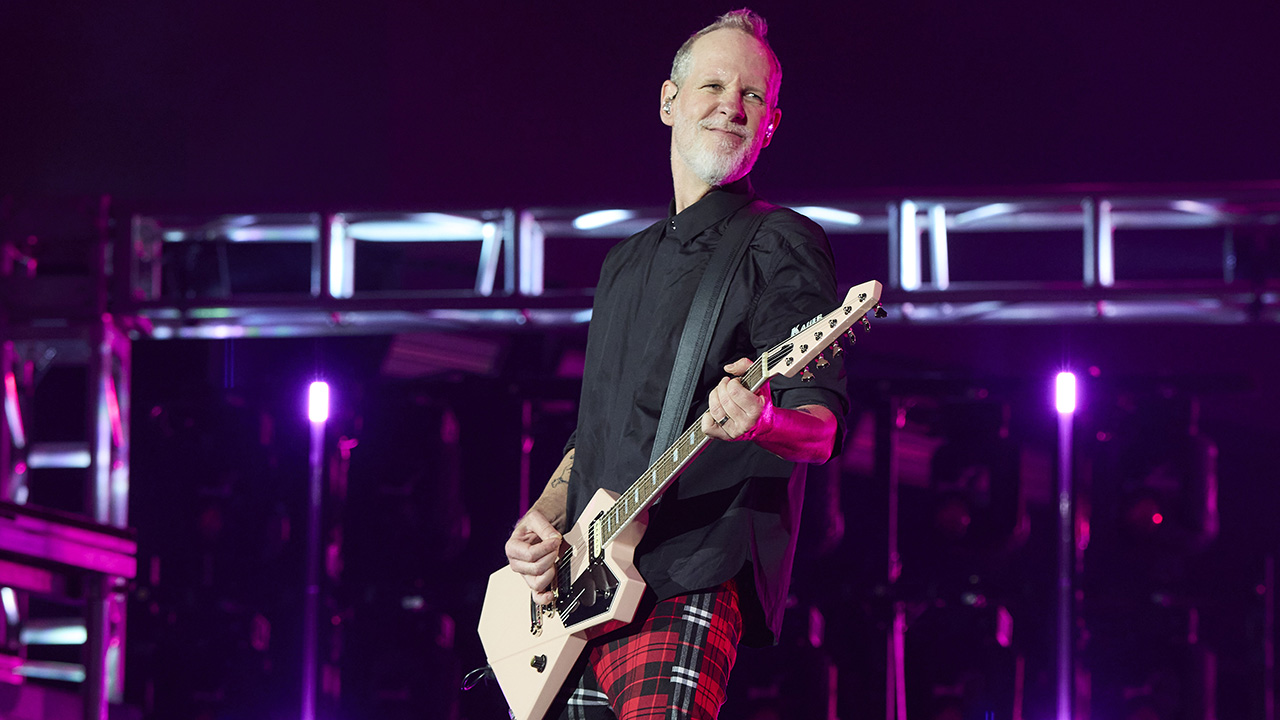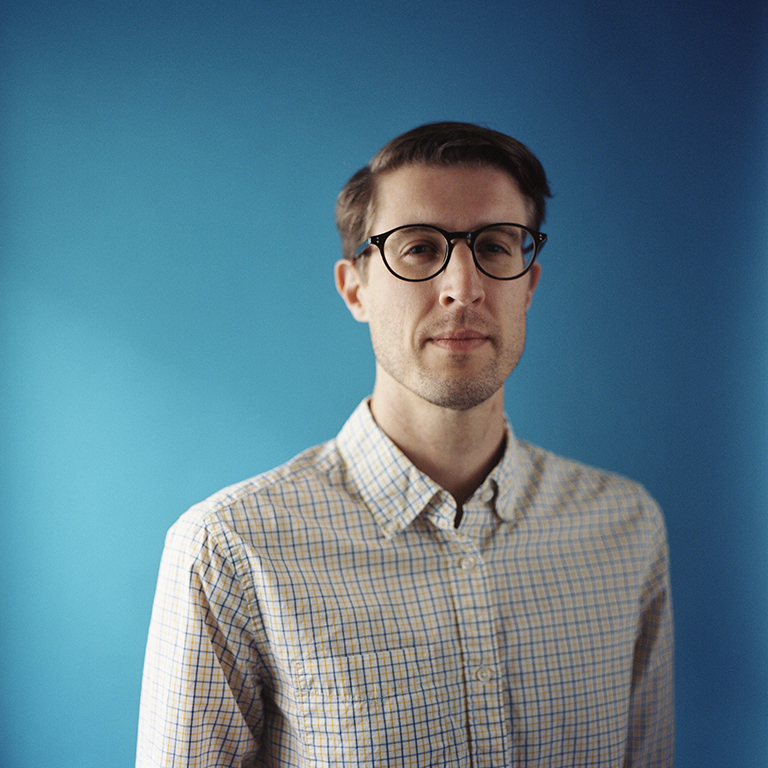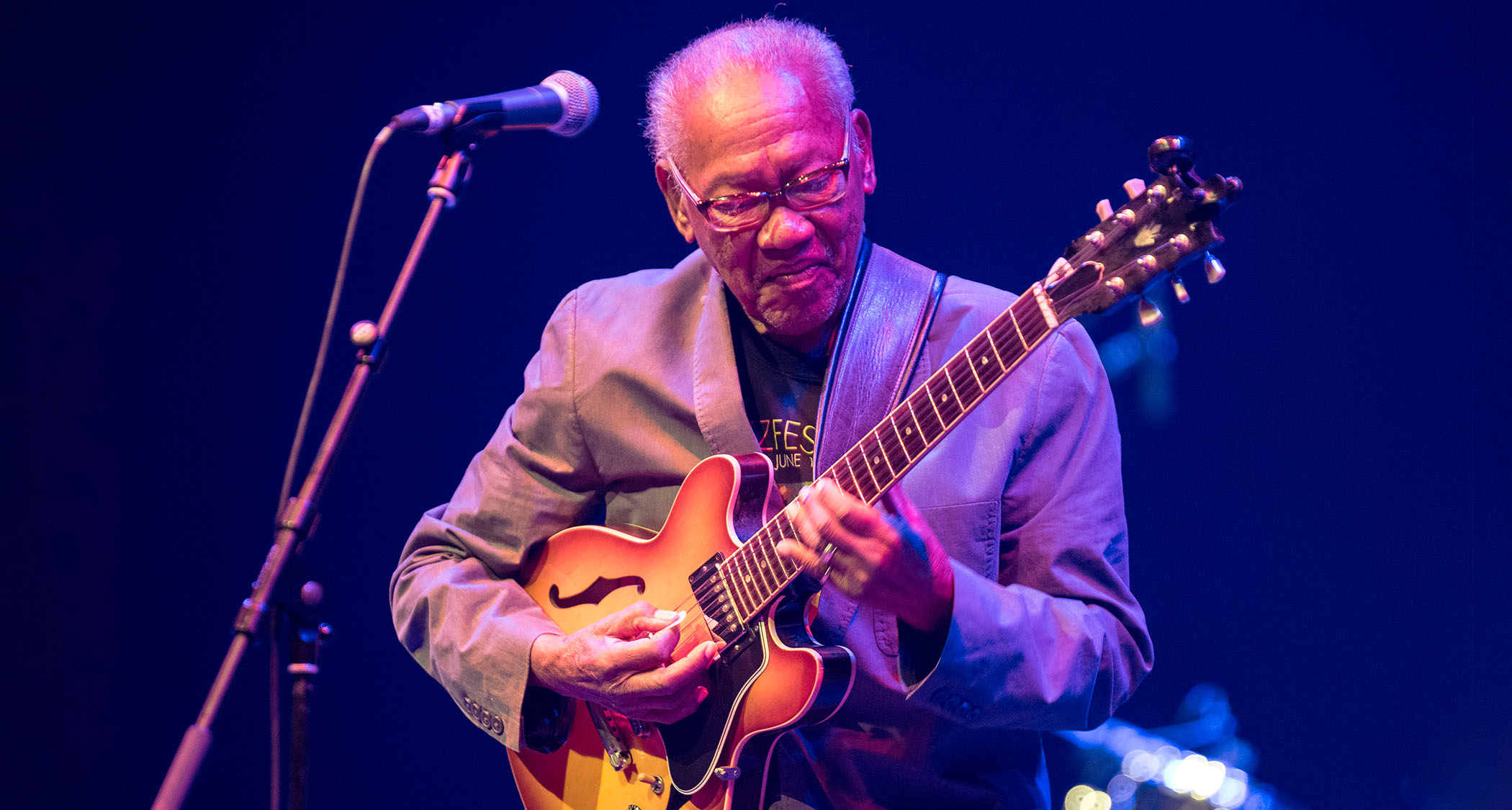“There’s an early No Doubt song which might as well be full-on heavy metal, if you want to hear Gwen singing for Black Sabbath. And there’s an absolutely shredding solo!” No Doubt’s Tom Dumont names 10 guitarists (and one genre) that shaped his sound
The No Doubt and Dreamcar guitarist attempted two Rush songs at a seventh-grade talent show, chunked up on Black Sabbath and later named his son after Ace Frehley – but reggae got deepest into his heart

If you thought it was surreal to see No Doubt ruling last month’s Coachella festival during a pair of reunion sets, you’re not alone.
Tom Dumont, the band’s guitarist since 1988, admits he was extra-anxious over the SoCal group’s first public performances in nine years. And when your long-awaited return happens to be on a massive desert stage in front of hundreds of thousands of concertgoers, that’s the kind of pressure that brings on a gut-wrenching attack of nerves.
“I was like, ‘God, what if I get up there and freeze, or start brain-farting all my parts?’” Dumont recalls, explaining that these days he’s often more focused on photography and being a dad than keeping up his six-string skills.
The good news is that Dumont, vocalist Gwen Stefani, bassist Tony Kanal and drummer Adrian Young, along with longtime multi-instrumentalists Gabrial McNair and Stephen Bradley, appeared in peak form as they ran through some of their biggest hits of the ‘90s and early ‘00s.
Dumont credits tons of rehearsal on his fleet of Hamer and Kauer offsets for building his callouses back up. And jumping into something like the twitchy, palm-muting lead lick to I’m Just a Girl is still second nature, some 30 years on. He suggests he goofed a few notes during the fluttery acoustic solo of Don’t Speak – but the shows generally went off without a hitch.
“That’s just part of being human, and of being a musician who hasn’t been on the road for a long time,” he reflects. “The beauty of those flubs is that everybody just keeps going. No disasters happened!”
It’s been a busy year for Dumont. Ahead of getting No Doubt back together, he booked a two-show return with Dreamcar, his ‘80s-style pop project with Kanal, Young and AFI vocalist Davey Havok. The guitarist is in the process of relearning the act’s 2017 self-titled record for a pair of shows this month.
All the latest guitar news, interviews, lessons, reviews, deals and more, direct to your inbox!
Both bands’ schedules are up in the air beyond the spring performances. “Let’s just do these things, and we’ll see what the future brings,” Dumont says. “We don’t have specific plans.”
Dreamcar did, however, just dish out their new, independently released Dream EP. It comprises two ‘verbed-out anthems they banked a few years back, and a newer, glam-slammed take on David Bowie’s Moonage Daydream, cut in Young’s basement.
While he’s been loading up his old guitar stems to get back in Dreamcar’s groove, Dumont suggests that following the guide hasn’t always been his vibe. “I wasn’t great at learning things note-for-note. I would put on a record, figure out the key, jam along, and by the second chorus I would just wheedle solos. There was a laziness there!”
Prior to linking up with No Doubt, he was a prospective metalhead crushing solos in a group called Rising. His time in the L.A. metal scene came to end when he determined he wasn’t interested in competing with the scene’s speed freaks. “I would go see Racer X, and Paul Gilbert and the bass player [Juan Alderete] were just shredding balls like you wouldn’t believe. I loved it – but I could never do it.
“When I joined No Doubt, one of the things I loved was that it had nothing to do with shredding. I could fit in really well because it wasn’t about how rippin’ the guitar player was. It was a completely different aesthetic. It was very exciting, beautiful, and musical to me.”
The band leaned heavily into two-tone ska rhythms pretty much from 1995 mega-smash Tragic Kingdom onward. But upstrokes have been just one aspect of Dumont’s guitar style. His melodic versatility has brought Sunset Strip-inspired pinch squealing together with Sunkist-branded Orange County ska (Spiderwebs), while also exploring cavernous dub minimalism (Hey Baby), ragtime-injected-pop punk (Excuse Me, Mr.), and flanged-out sophisti-pop (their 2003 take on Talk Talk’s It’s My Life).
He developed that chameleon-like adaptability to serve the song, rather than his ego. “I decided a long time ago that I want guitar playing to always be fun, and never a chore,” he says. “That plays into the idea that I was never great enough to be a virtuoso. I’m happy being a member of a band, and doing as well for that band as I can.”
It’s perhaps fitting, then, that the players that most influenced him run the gamut from approachably iconic rifflords to a mix of six-stringers completely uncaged by genre constraints.
1. Ace Frehley
“Ace Frehley was probably my first guitar influence, because Kiss was the first rock band that I got into – you know, being 10 years old and getting Kiss albums for Christmas. They look like comic book heroes and Ace Frehley was just so cool. I actually named my first son Ace.
“Kiss was just really simple hard rock music. What I really liked about Ace’s playing was that his solos, especially, were very memorable. He wasn’t a ripper, but all of his stuff was so tasty and melodic. I went and saw them 20 years ago, when Ace last played with them, and I was so stoked to hear him play those solos.
“My favorite songs were 100,000 Years and Black Diamond. Just great rock riffs. The music from when you’re 10 years old gets stuck in your brain forever, so his playing just scratches that itch.”
2. Neil Young
“After having fallen in love with Kiss, I started learning how to play on an acoustic guitar my dad had. I wanted to learn Kiss and Black Sabbath songs, but the guitar teacher at my local music store didn’t know any of that.
“He was like, ‘Well, let’s start with James Taylor.’ So that’s how I started. I took lessons for six months, learned to strum a whole bunch of chords, and then I quit and self-taught from there.
“The acoustic version of Neil Young’s My My, Hey Hey off Rust Never Sleeps was a big influence – just the interplay of how he’s playing a melody line on the guitar while strumming the chords. The song is really beautiful. I don’t know how these things seep in to my playing, but Neil Young’s a big one.”
3. Tony Iommi
“Black Sabbath is perfect music for a teenage boy, as far as actually learning riffs like Iron Man, Paranoid and Fairies Wear Boots. So fun to play, and they were simple enough that I could really learn what Tony Iommi was doing with those root fifth barre chords. So simple and chunky. Tony invented a whole genre of music!
“There’s an early No Doubt song called Snakes, which might as well be a full-on heavy metal song. If you want to hear Gwen singing for Black Sabbath, look up Snakes on our Beacon Street Collection album. And there’s just an absolutely shredding solo on there!”
4. Alex Lifeson
“What was really cool is that Rush were a hard rock band that became a prog rock band. Then they went into their new wave stage, and I was there for most of that. They evolved a lot!
“There’s a song on Moving Pictures called Vital Signs where there’s a little bit of a reggae influence to the way Alex Lifeson is approaching the guitar. The Spirit of Radio has a little bit of a reggae section, too. I didn’t know anything about reggae music at the time, so it first got into me through Alex Lifeson.
“Most of his stuff was hard for me to play. When I was in my first-ever band in seventh grade, we covered Overture and Temples of Syrinx – two instrumental songs from 2112 – at the talent show. Not that we nailed it… I’m sure it sounded terrible! But that’s pretty ambitious for seventh-graders.”
5. David Gilmour
“The Wall was huge for me. There’s a lot more to sync into David Gilmour’s guitar playing than heavy rock. There was Another Brick in the Wall, Part 2, where he was playing this disco stuff; there’s great acoustic work; there’s epic solos, like on Comfortably Numb.
“I loved how that album was such a journey. That was probably a big influence on me as well.”
6. The Edge
“Even though I was a heavy metal kid, I discovered U2 on MTV. The Edge was a badass guitar player who did something completely different from Black Sabbath and Van Halen. It was so innovative, with the delays and his 16th note stuff.
“Gloria, Sunday Bloody Sunday and New Year’s Day – just huge songs. The Edge informed a lot of my playing in Dreamcar.”
7. Steve Bartek
“Oingo Boingo was an institution in Orange County when I was growing up. Every Halloween they would sell out three nights at Irvine Meadows, the big amphitheater by my house. When I joined No Doubt my first thought was, ‘This is like Oingo Boingo.’
“They weren’t a ska band but they had elements of ska, rock and new wave, while also being completely unique sounding. Steve Bartek was not a ska guitar player; he was a rock guitar player. But he played in an innovative way, compared to the heavy metal stuff I was listening to.”
8. Lynval Golding
“Madness, the Selecter and the Specials were the big bands that influenced the early days of No Doubt. Learning how Lynval played rhythmically in a ska band informed a lot of what I did early on.
“The Specials’ Gangsters is the song. There’s a big riff, but also the really tight, upbeat ska parts with clean tones. That was a huge adjustment for me when I joined No Doubt.
“In my heavy metal band, everything was full blast – overdrive and distortion the whole time. It was the opposite in No Doubt; I had to relearn how to play with fully clean guitars.”
9. Andy Taylor
“When we started Dreamcar, I was trying to find things that would inspire me. There’s a bunch of our songs that are really inspired by The Edge and U2; but the other band that I found I loved was Duran Duran.
“The way Andy Taylor approaches melodic guitar lines on songs like Planet Earth and Girls on Film is something I didn’t do a lot with No Doubt. I was able to do a lot more of that stuff with Dreamcar. Since delays and choruses help fill up space so much, you can do single-note melodic lines and counter melodies to the vocal really well, and I loved the way Andy did that.
“And I loved that saturated tone he had. I don’t know what gear he was playing through. A lot of people were using the Roland Jazz Chorus then, which I’ve approximated with the Kemper.”
10. Andy Summers
“The Police reminded me of Rush in a way, being a three-piece where the bassist sings. Sting was a wicked bass player; Sting and Stewart Copeland were pretty busy players. Andy Summers was almost never busy – he was always laid back.
“In some ways, I identify with that: it’s been my approach in No Doubt a lot of the time; though not all the time. Looking back, there are some solos he did that frustrated me because he’s such a great player. But I love it all rhythmically.
“So Lonely was perfect. It’s this reggae/ska thing, then he gets into this punky chorus, but it was all clean tones. That’s a lot of what I did in No Doubt – I was never thinking, ‘I’m going to do an Andy Summers,’ but that stuff gets in your brain. You absorb it and fart it back out at a later time.”
11. Reggae music
“When I was in college and had just joined No Doubt, I was awakened to reggae music. I was never a follower of a certain reggae guitar player, though. I was the kind of person who would love albums, but not necessarily geek on who the guitar player was. I would just absorb it.
“Everybody had the Bob Marley Legend record. There were certain albums by Steel Pulse, Peter Tosh, and all those the big Jamaican bands – but I couldn’t say that I ever knew each guitar player’s name. That’s not out of disrespect. I loved the music. It’s synced its way into me.”
Gregory Adams is a Vancouver-based arts reporter. From metal legends to emerging pop icons to the best of the basement circuit, he’s interviewed musicians across countless genres for nearly two decades, most recently with Guitar World, Bass Player, Revolver, and more – as well as through his independent newsletter, Gut Feeling. This all still blows his mind. He’s a guitar player, generally bouncing hardcore riffs off his ’52 Tele reissue and a dinged-up SG.

